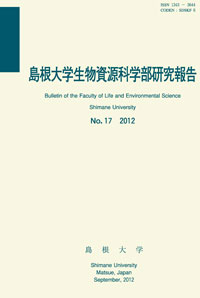島根大学生物資源科学部
ISSN:2435-0885(オンライン)
ISSN:1343-3644(冊子体)
なお、冊子体の刊行は23巻まで
ISSN:1343-3644(冊子体)
なお、冊子体の刊行は23巻まで

ダウンロード数 : ? 件
この文献の参照には次のURLをご利用ください : https://ir.lib.shimane-u.ac.jp/4795
島根大学生物資源科学部研究報告 7
2002-12-20 発行
島根県に発生した突然変異イネ群に存在する抗菌物質
Anti-fungal Compounds from Lesion Mimic Mutant of Rice Found in Shimane Prefecture
ファイル
内容記述(抄録等)
In 2000, lesion mimic mutants of rice were found from cvs. Koshihikari and Nipponbare in eight paddy fields of Shimane Prefecture. Necrotic spots were formed on the leaves of these mutants at the late stage of growth. When 80% ethanol extracts from leaves of each mutant with necrotic spots were spotted on the TLC plates, and B. oryzea were sprayed on the plates, growth inhibition zones were observed. When ethanol extracts were developed by TLC, no difference was observed in TLC-profiles of compounds with positive response to a ninhydrin reagent among mutants. Tryptamine found from mutant rice cv. Sekiguchi-asahi was not detected in each extract from mutants. Antifungal activity was observed in neutral fraction of benzene extract and in acidic fraction of EtoAc extract from ethanol extract, respectively, as demonstrated by growth inhibition and spore germination tests. This result suggested that there were at least two antifungal compounds in the leaves. This study indicated that antifungal compound plays an important role as a possible factor in resistance of lesion mimic mutant of rice.
About This Article
Other Article
